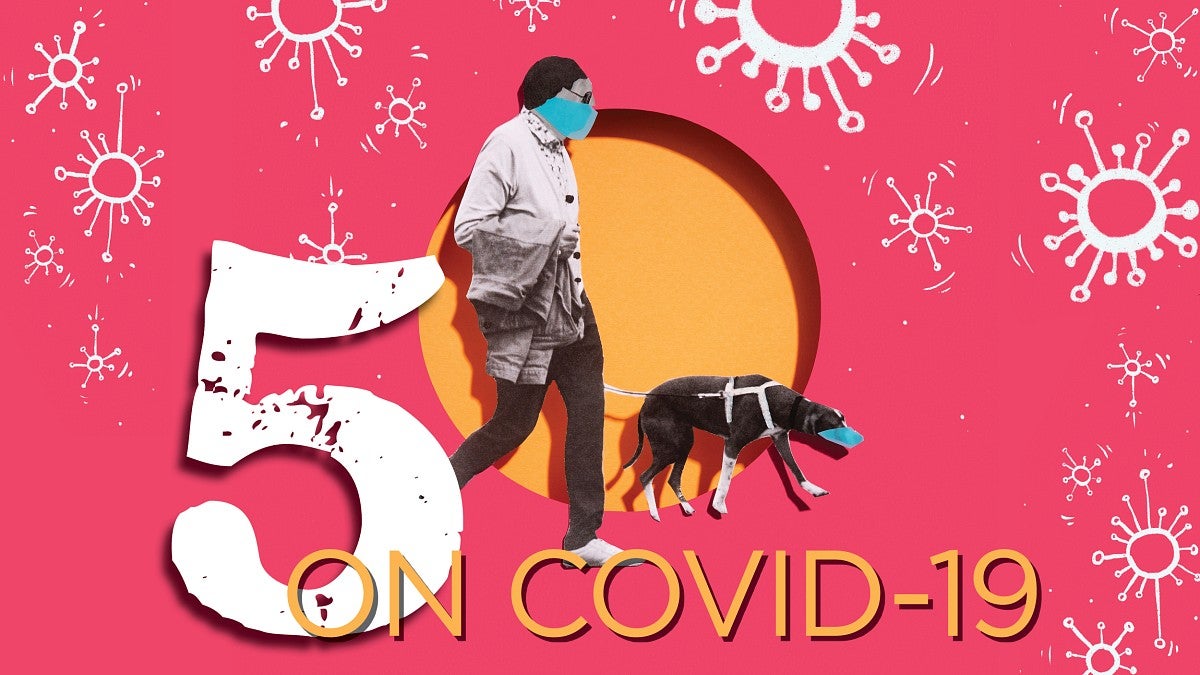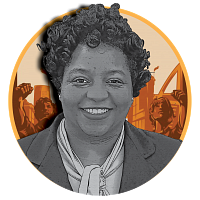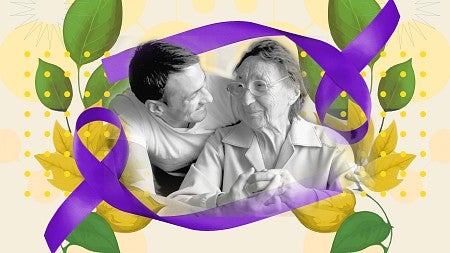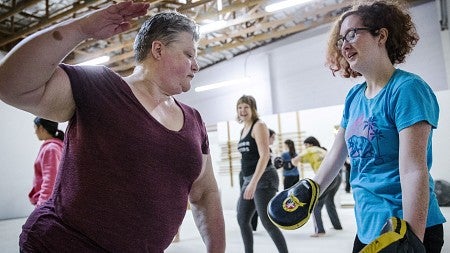
It’s been six months since the first confirmed case of coronavirus in the United States was announced: what do we know? COVID-19 continues to confound, subsiding and resurging. The economy falters, buildings close and open, we hunt for useful virus data while managing upended lives.
But knowledge steadies us, illuminating the way forward. To help chart that course, Oregon Quarterly consulted five UO experts: economist Tim Duy, law professor Latisha Nixon-Jones, data specialist Ellen Peters, architecture professor Kevin Van Den Wymelenberg, and biologist Janis Weeks. What questions are they asking? What issues are they examining? What do they think we need to know?
Through their eyes, we gain a layered understanding of a disease with many sides. Call it perspective on a pandemic.
Tim Duy
Economy

When he considers the pandemic-driven economic downturn, Professor of Practice Tim Duy says it’s not quite a depression, but it’s deeper than a recession.
That’s why the UO economist calls it the Great Suppression, in contrast with the Great Depression of the 1930s, when a financial shock reverberated through the economy.
Due to COVID-19, “we suppressed economic activity to try to suppress the virus,” says Duy, who’s been cited in coronavirus coverage by the New York Times, Bloomberg News, New York magazine, and Forbes. “The economy faded out because we flipped the switch.”
The road to economic recovery isn’t clear because this decline is unprecedented, Duy says. The speed of the decline is greater than that in the Depression.
“This isn’t a typical business cycle, where a negative economic shock propagates through the economy fairly slowly over months,” he says. “This came all at once. We just turned off a lot of business rather than adjusting economic activity slowly, as in a recession.”
He predicts there will be some economic growth this summer, but the duration of this downturn is unknown. Some jobs will come back quickly, such as in the medical profession, where people can resume elective surgeries and buying eyeglasses, for instance, Duy says.
What won’t come back quickly are events with dense crowds of people—sporting events, concerts, and conferences.
In addition, so many workers have been laid off in such a short period of time that it will take time to match workers with new firms. If companies can’t take back their old workers, “there’s going to be persistent damage,” Duy says, including companies shutting for good.
Because Oregon is more reliant on manufacturing activity, it may fare better in recovery than states that rely more heavily on tourism, such as Hawaii, Duy says.
The bigger question is how society and the economy will adjust to the post-pandemic world. Duy says he wonders how we’ll replace sporting events, festivals, and conferences—all economic drivers that also can be “super-spreader” events for the virus.
The main economic recovery tool will be controlling the virus, which is why vaccine development is so critical.
“Dealing with the virus will allow us to resume normal economic activity,” Duy says.
Latisha Nixon-Jones
Legal Rights

People are accustomed to evacuation requirements during hurricanes or shelter-in-place directives in advance of a tornado.
But those orders play out over short periods. There are no signs COVID-19 will be quickly eliminated—and that raises challenging questions for authorities and the legal community, says Latisha Nixon-Jones, visiting legal research and writing professor in the School of Law.
“This (pandemic) is something that’s unprecedented so it’s testing the boundaries of laws that we have in place right now,” she says. “There has always been a balance between civil liberties and policing power.”
Regarding civil liberties during a pandemic, some people balk at rules and guidelines intended to slow the spread of disease, such as requiring the wearing of face masks.
On top of that, as the country adjusts to the pandemic, some regions are bracing for the next emergency: hurricanes, floods, and other natural disasters.
That will put pressure on state and federal emergency management officials to manage new threats while responding to COVID-19 Nixon-Jones says.
“History has shown us that Black and Brown communities, veterans, and low-income communities are often disproportionately affected by disasters and take longer to recover,” she adds. “It is important for the government and communities to start preparedness outreach early and often to equip these populations with the tools they need in the event of a natural disaster during the pandemic.”
The next wave of natural disasters will also coincide with the expiration of measures taken to help people during the pandemic, such as extended unemployment benefits and the CARES Act, meant to address economic fallout from COVID-19.
After the pandemic hit, many state and local governments placed a moratorium on evictions. When those moratoria end, will housing officials face a trickle—or a tidal wave—of families needing housing?
“State and local governments will have to assess and adjust their emergency management or disaster plan in accordance with Centers for Disease Control and Prevention and Occupational Safety and Health Administration guidelines to protect and prevent an increase in transient housing in their jurisdiction,” Nixon-Jones says.
Ellen Peters
Virus Data

Being able to understand numbers is a basic skill that helps people make better decisions, manage their money, and generally be more successful in life.
Now it turns out being numerically literate, or “numerate,” may help you come out of the pandemic in one piece as well, says Philip H. Knight Chair Ellen Peters, director of the Center for Science Communication Research in the School of Journalism and Communication. Peters discusses similar number problems in her newly-released book, Innumeracy in the Wild: Misunderstanding and Misusing Numbers.
Specifically, Peters points to the accuracy of antibody tests, which are intended to show if a person has been infected with COVID-19.
Such tests could prove important because if someone had the virus and survived, they may be immune to future infection. If enough people are immune, it may help combat the spread of the virus, and would amount to a “get out of jail free card,” Peters says.
But the accuracy of these antibody tests, widely available on the internet, are problematic, to say the least. To understand why requires some understanding of numbers, as well as a useful mathematical theorem.
The antibody tests authorized by the Food and Drug Administration have true positive rates, or “sensitivity,” of 88 to 100 percent, and true negative rates, or “specificity,” of 94 to 100 percent, Peters says. The terms refer to the accuracy of the tests in identifying whether one has the antibodies (positive) or doesn’t (negative).
“On one hand, this is fantastic news,” Peters says. “But a closer look reveals these tests aren’t perfect. Just because you test positive doesn’t mean you had the virus. You need to know more.”
Specifically, you need another number: the percentage of the population that has been infected with COVID-19. The FDA estimates 5 percent of the US population has been infected.
Using that number, and plugging all these variables into Bayes' Theorem—a method for calculating probability—we learn that the likelihood that someone is immune, given that they’ve tested positive in an antibody test, ranges from 47 to 100 percent, Peters says.
“People, even if they are highly numerate, find this intuition and these calculations difficult,” she adds.
“There’s a lot of uncertainty here but if you pay attention, understand numbers, and use numbers to your advantage, you can make better decisions,” Peters says. “If you understand the antibody tests—and the math involved—you can make better choices.”
Kevin Van Den Wymelenberg
Buildings

When Kevin Van Den Wymelenberg thinks about the future of buildings and public spaces in the age of COVID-19, he considers how people learned to think about fire danger.
At an early age, we are taught fire drills, so we know to get out of a building on fire. When we hear a fire alarm or smoke detector sound, we know danger is near. We equip our buildings with sprinkler systems and fire extinguishers. All these are part of the background of our daily lives.
When it comes to living with COVID-19 and future pandemics, “there may be a practice like that we may need to consider,” he says.
Van Den Wymelenberg directs the Biology and the Built Environment Center and the Institute for Health in the Built Environment, both at the UO. He studies how buildings are designed, built, and managed, and how that affects human health and the environment.
“There’s a balance between saving lives and restoring livelihoods and both really matter and both impact public health as well as the economy,” Van Den Wymelenberg says.
As the pandemic spread this spring, he and his colleagues published guidelines for making a wide range of indoor spaces as safe as possible, with a caveat: “There’s not a way to eliminate risk,” he says.
One important thing building managers can do is increase outdoor air exchange through opening windows or mechanical systems, or a combination of both, he says.
Regarding new buildings or retrofits, it’s also helpful to separate ventilation from heating and cooling systems for energy savings and comfort, Van Den Wymelenberg says.
Indoor humidity also affects health: keeping humidity between 40 and 60 percent has been shown to support human immune function and it causes floating viral particles to settle on surfaces more quickly so they are less likely to be inhaled and can instead be wiped away.
Returning to the fire analogy, he says that just as a national forest has a sign indicating the level of fire danger on a given day, buildings could have signs, or cities could have notices, indicating whether viral transmission risks are low, medium, or high.
To do that, Van Den Wymelenberg and colleagues are working on technology that would allow rapid testing of buildings for viruses. They’re currently working with corporations and raising funds to develop that technology and have already begun testing buildings manually.
Janis Weeks
Pandemics

As an expert in emerging infectious diseases, Janis Weeks has not found anything about the COVID-19 pandemic particularly surprising.
“The fact is, there’s huge pandemic potential from zoonotic diseases that jump from animals to humans,” she says.
Weeks, a professor emerita in the biology department, teaches classes on infectious and parasitic diseases, including emerging infectious diseases.
“It's an absolutely riveting, while terrifying, topic,” Weeks says. “I show the film Contagion in my class, which depicts a viral outbreak that causes global panic and military-enforced quarantines of major cities, through the eyes of an ordinary family. I also use excerpts from the book Spillover by David Quammen; he’s an excellent science writer who explains human factors such as habitat destruction that fuel zoonotic pandemics, and why these outbreaks are an inevitable aspect of the world we live in. I'm now rereading World War Z by Max Brooks, which is about zombies, but is an amazingly realistic depiction of how pandemics can play out.”
Looking at how the COVID-19 pandemic may progress in coming months, Weeks quotes Anthony Fauci, director of the National Institute of Allergy and Infectious Diseases.
“The virus sets the timeline,” she says. “The virus is going to do what it wants to do. It may become more dangerous and transmissible, or it may become milder. There’s no solid evidence for either at this point in time.”
According to Weeks, even when a vaccine for COVID-19 becomes available, it remains to be seen whether it will provide lifetime immunity, as with smallpox vaccine, or short-term immunity, as with the influenza vaccine, which is reformulated every year.
Knowing the world will be confronted by another pandemic, Weeks says, governments should prepare now by making sure we have enough personal protective equipment on hand and by funding research. She also believes the US should strengthen public health partnerships around the world, including countries with a history of pathogens jumping from animals to humans.
The president’s terminating funding to the World Health Organization in the middle of a pandemic, Weeks says, “is like cutting funding to a fire department during a conflagration.”
Tim Christie is a staff writer for University Communications




